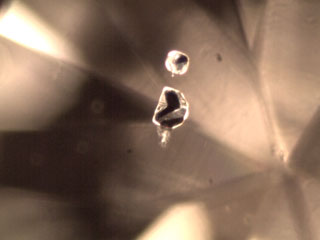An internal crystal in a diamond refers to a type of inclusion (a naturally occurring characteristic inside the diamond). These crystals can be small mineral particles or other forms of inclusions trapped within the diamond during its formation deep within the Earth. Internal crystals are often used by gemologists to identify a diamond and can have an impact on the diamond’s appearance, clarity, and value.
Key Points about Internal Crystals in Diamonds:
Types of Internal Crystals:
Mineral Crystals: These are the most common type of internal crystals found in diamonds. They are usually small mineral particles that were trapped inside the diamond during its formation. These mineral crystals could be made of other minerals like garnet, peridot, or even graphite.
Diamond Crystals: Occasionally, diamonds may contain tiny crystals of diamond itself within them. These are rare but can appear as inclusions that look like tiny diamonds or clusters of diamond particles within the main diamond.
Other Inclusions: Other forms of inclusions, such as feathers, clouds, or blotches, might also contain internal crystals, but these are less common.
Impact on Clarity:
Clarity Grade: Internal crystals are considered inclusions, and they affect a diamond’s clarity grade. The presence of these inclusions can lower the clarity rating of a diamond, especially if the crystal is large, visible to the naked eye, or affects the overall appearance of the stone.
Diamonds are graded on clarity from Flawless (FL) to Included (I) based on the visibility and size of these internal characteristics. The larger and more noticeable the crystal, the more it can impact the clarity grade.
Visible Internal Crystals:
Inclusions Visibility: Some internal crystals may be visible to the naked eye, especially if they are large or located near the surface of the diamond. In other cases, they may be microscopic and only visible under magnification.
Location: The location of the internal crystal inside the diamond also plays a role in its visibility. If it’s near the surface, it may cause the diamond to have blemishes on the surface (as the crystal could potentially cause a chip or fracture if it’s not cut properly).
Internal Crystals and Diamond Value:
Negative Impact on Value: Larger, visible internal crystals generally decrease a diamond’s value, as they affect the clarity grade and overall appearance. The more inclusions there are inside the diamond, the lower the diamond’s clarity and value.
Exceptions: Sometimes, small internal crystals that are not visible to the naked eye may have little to no effect on the diamond’s appearance or value. In some cases, they might even add uniqueness to the diamond, especially if they are particularly small or unique in appearance.
Internal Crystals and Diamond Identification:
Unique Fingerprints: Every diamond contains its own unique combination of inclusions, including internal crystals, which makes diamonds identifiable. Gemologists use these characteristics, known as the diamond’s “fingerprint,” to confirm the diamond’s authenticity and traceability.
Laser Inscriptions: Some diamonds may have laser inscriptions on the girdle (the outer edge of the diamond) that record a unique identification number, which can be cross-referenced with a diamond’s internal characteristics and certificate.
Crystal Inclusions in Fancy Color Diamonds:
In fancy color diamonds, the presence of internal crystals can sometimes enhance or influence the overall color appearance of the diamond. For example, certain internal inclusions might give the diamond a different hue or intensity of color, particularly in diamonds with natural color variations like pink, blue, or green.
Crystal Inclusions and Durability:
The impact of internal crystals on a diamond’s durability depends on their size and location. While diamonds are incredibly strong and durable, large internal crystals near the surface may create weaknesses or make the diamond more prone to breaking or chipping.
Smaller internal crystals that are positioned away from the surface tend to have little impact on the diamond’s durability.
Summary:
Internal Crystal: An inclusion made up of a small mineral or diamond particle trapped inside the diamond during its formation.
Effect on Clarity: Internal crystals can lower a diamond’s clarity grade, especially if they are large or visible to the naked eye.
Identification: Internal crystals can act as a unique “fingerprint” for identifying a diamond.
Impact on Value: Larger, visible internal crystals can decrease the value of a diamond, though small, microscopic crystals may not have much impact.
Durability: Internal crystals near the surface can weaken the diamond and increase the risk of chipping.

